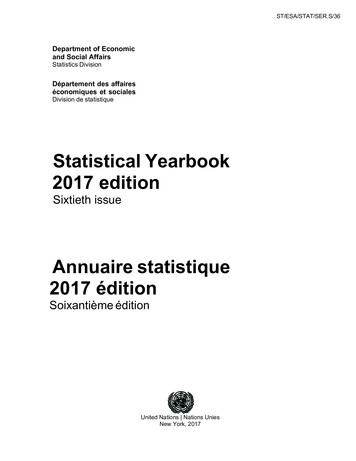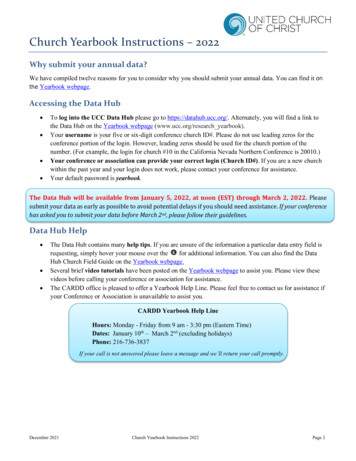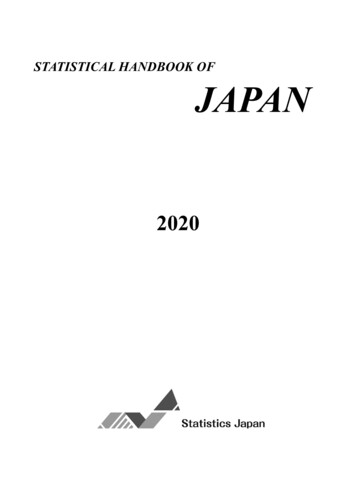
Transcription
ST/ESA/STAT/SER.S/36Department of Economicand Social AffairsStatistics DivisionDépartement des affaireséconomiques et socialesDivision de statistiqueStatistical Yearbook2017 editionSixtieth issueAnnuaire statistique2017 éditionSoixantième éditionUnited Nations Nations UniesNew York, 2017
Department of Economicand Social AffairsDépartement des affaireséconomiques et socialesThe Department of Economic and Social Affairs of theUnited Nations Secretariat is a vital interface betweenglobal policiesin the economic, social andenvironmental spheres and national action. TheDepartment works in three main interlinked areas: (i) itcompiles, generates and analyses a wide range ofeconomic, social and environmentaldataandinformation on which Member States of the UnitedNations draw to review common problems and to takestock of policy options; (ii) it facilitates the negotiationsof Member States in many intergovernmental bodies onjoint courses of action to address ongoing or emergingglobal challenges; and (iii) it advises interestedGovernments on the ways and means of translatingpolicy frameworks developed in United Nationsconferences and summits into programmes at the countrylevel and, through technical assistance, helps buildnational capacities.Le Département des affaires économiques et sociales duSecrétariat de l’Organisation des Nations Unies assure le lienessentiel entre les politiques adoptées au plan internationaldans les domaines économique, social et écologique et lesmesures prises au plan national. Il mène ses activités danstrois grands domaines interdépendants : i) il compile, produitet analyse une grand variété de données et d’informationséconomiques, sociales et écologiques dont les États Membresde l’ONU tirent parti pour examiner les problèmes communs etfaire le point sur les possibilités d’action; (ii) il facilite lesnégociations que les États Membres mènent dans un grandnombre d’organes intergouvernementaux sur les moyensd’action à employer conjointement pour faire face auxproblèmes mondiaux existants ou naissants; et (iii) il aide lesgouvernements intéressés à traduire les orientations politiquesétablies lors des conférences et sommets de l’ONU enprogrammes nationaux et contribue à renforcer les capacitésdes pays en leur apportant une assistance technique.NoteNoteThe designations employed and the presentation ofmaterial in this publication do not imply the expression ofany opinion whatsoever on the part of the Secretariat ofthe United Nations concerning the legal status of anycountry, territory, city or area; or of its authorities, orconcerning the delimitation of its frontiers or boundaries.In general, statistics contained in the presentpublication cover a period up to 2017 and as available tothe United Nations Secretariat as of 31 July 2017. Theyreflect the country nomenclature currently in use.The term “country” as used in the text of this publicationalso refers, as appropriate, to territories or areas.The designations “developed” and “developing” whichappear in some tables are intended for statisticalconvenience and do not necessarily express a judgementabout the stage reached by a particular country or area inthe development process.Symbols of the United Nations documents arecomposed of capital letters combined with figures.Les appellations employées dans la présente publication et laprésentation de données qui y figurent n’impliquent, de la partdu Secrétariat de l’Organisation des Nations Unies, aucuneprise de position quant au statut juridique des pays, territoires,villes ou zones, ou de leurs autorités, ni quant au tracé deleurs frontières ou limites.En règle générale, les statistiques contenues dans laprésente publication couvrent pour la période jusqu'en 2017 etsont celles dont disposait le Secrétariat de l’Organisation desNations Unies au 31 juillet 2017. Elles reflètent donc lanomenclature de pays en vigueur à l’époque.Le terme « pays », tel qu’il est utilisé dans la présentepublication peut également désigner des territoires ou deszones.Les appellations « développées » et « en développement »qui figurent dans certains tableaux sont employées à des finsexclusivement statistiques et n’expriment pas nécessairement unjugement quant au niveau de développement atteint par tel paysou telle région.Les cotes des documents de l’Organisation des NationsUnies se composent de lettres majuscules et de chiffres.ST/ESA/STAT/SER.S/36UNITED NATIONS PUBLICATIONSales No. B.17.XVII.1.HISBN 978-92-1-061401-6e-ISBN 978-92-1-362703-7ISSN 0082-8459Copyright United Nations, 2017All rights reservedST/ESA/STAT/SER.S/36PUBLICATION DES NATIONS UNIESNuméro de vente: B.17.XVII.1.HISBN 978-92-1-061401-6e-ISBN 978-92-1-362703-7ISSN 0082-8459Copyright United Nations, 2017Tous droits réservés
PrefaceThe 2017 edition of the United Nations Statistical Yearbook is the sixtieth issue of the publication, prepared by theStatistics Division of the Department of Economic and Social Affairs. Ever since the compilation of data for the StatisticalYearbook series was initiated in 1948, it has consistently provided a wide range of internationally available statistics onsocial, economic and environmental conditions and activities at the national, regional and world levels.The contents of the Yearbook continue to be under review and additional tables are expected to be introduced in futureeditions. Please send any comments or views to our email address, statistics@un.org. The tables include series covering anappropriate historical period, depending upon data availability and space constraints, for as many countries, territories andstatistical areas of the world as available. The tables cover a period up to 2017, with some of the data being estimated.The Yearbook tables are based on data which have been compiled by the Statistics Division mainly from official nationaland international sources as these are more authoritative and comprehensive, more generally available as time series andmore comparable among countries than other sources. These sources include the United Nations Statistics Division in thefields of national accounts, industry, energy and international trade, the United Nations Statistics Division and thePopulation Division in the field of demographic statistics, and over 20 offices of the United Nations system andinternational organizations in other specialized fields. In some cases, official sources have been supplemented by othersources and estimates, where these have been subjected to professional scrutiny and debate and are consistent with otherindependent sources.The United Nations agencies and other international, national and specialized organizations which furnished data are listedunder “Source” at the end of each table. Acknowledgement is gratefully made for their generous and valuable cooperationin continually providing data.After the first table, which presents key world aggregates and totals, the Yearbook is organized in three parts as follows;part one, relating to population and social topics; part two, relating to economic activity; and part three relating to energy,environment and infrastructure. The tables in the three parts are presented mainly by countries or areas, and world andregional aggregates are shown where available.The four annexes contain information on country and area nomenclature (annex I), summary technical notes on statisticaldefinitions, methods and sources for all tables of the Yearbook (annex II), the conversion coefficients and factors used incertain tables (annex III), and a list of those tables which were added, omitted or discontinued since the last issue of theYearbook (annex IV).The Statistical Yearbook is prepared by the Statistical Dissemination Section, Statistical Services Branch of the StatisticsDivision, Department of Economic and Social Affairs of the United Nations Secretariat. The programme manager isMatthias Reister and the chief editor is Ian Rutherford. They are assisted by David Carter, Anuradha Chimata, MohamedNabassoua, and Junping Bao. Bogdan Dragovic provided IT support.Comments on the present Yearbook and its future evolution are welcome. They may be sent via e-mail tostatistics@un.org or to the United Nations Statistics Division, Statistical Dissemination Section, New York, NY 10017,USA.Preface — Préface iii
PréfaceL’Annuaire statistique des Nations Unies 2017 est la cinquante-neuvième édition de cette publication, préparée par laDivision de statistique du Département des affaires économiques et sociales. Depuis son instauration en 1948 comme outilde compilation des données statistiques internationales, l’Annuaire statistique s’efforce de constamment diffuser un largeéventail de statistiques disponibles sur les activités et conditions économiques et sociales, aux niveaux national, régionalet mondial.Le contenu de l'Annuaire est actuellement en cours de révision et des tableaux seront inclus dans les prochaines éditions.Pour tout commentaire, veuillez envoyer un courriel à notre adresse électronique : statistics@un.org. Les tableaux présententdes séries qui couvrent une période historique appropriée, en fonction de la disponibilité des données et des contraintesd'espace, pour autant de pays, territoires et zones statistiques du monde comme disponibles. Les tableaux couvrentgénéralement la période allant jusqu'en 2017.Les tableaux de l’Annuaire sont construits essentiellement à partir des données compilées par la Division de statistique etprovenant de sources officielles, nationales et internationales; c’est en effet la meilleure source si l’on veut des donnéesfiables, complètes et comparables, et si l’on a besoin de séries chronologiques. Ces sources sont: la Division de statistiquedu Secrétariat de l’Organisation des Nations Unies pour ce qui concerne la comptabilité nationale, l’industrie, l’énergie etle commerce extérieur, la Division de statistique et la Division de la population du Secrétariat de l’Organisation desNations Unies pour les statistiques démographiques; et plus de 20 bureaux du système des Nations Unies etd’organisations internationales pour les autres domaines spécialisés. Dans quelques cas, les données officielles sontcomplétées par des informations et des estimations provenant d’autres sources qui ont été examinées par des spécialistes etconfirmées par des sources indépendantes.Les institutions spécialisées des Nations Unies et les autres organisations internationales, nationales et spécialisées qui ontfourni des données sont énumérées dans la “Source” sur chaque tableau. Les auteurs de l’Annuaire statistique lesremercient de leur précieuse et généreuse collaboration.Après le premier tableau qui fournit les principaux agrégats et totaux au niveau mondial, l’Annuaire est groupés en troisparties. La première partie est consacrée à la population et aux questions sociales, la deuxième est consacrée à l’activitééconomique, et la dernière est consacrée à l’énergie, environnement et infrastructures. Dans ces trois parties, les tableauxsont généralement présentés par pays ou régions, mais les agrégats mondiaux ou régionaux sont indiqués si disponibles.Les quatre annexes donnent des renseignements sur la nomenclature des pays et des zones (annexe I), des notesrécapitulatives sur les définitions, méthodes statistiques et techniques utilisées dans les sources de chaque tableau del’Annuaire (annexe II), ainsi que sur les coefficients et facteurs de conversion employés dans les différents tableaux(annexe III), enfin une liste de nouveaux tableaux, de tableaux omis ou supprimés depuis la dernière édition est disponible(annexe IV).L'Annuaire statistique est préparé par la Section de la diffusion statistique, Service des statistiques de services de laDivision de statistique, Département des affaires économiques et sociales du Secrétariat de l'Organisation des NationsUnies. La responsable du programme est Matthias Reister, et le rédacteur en chef est Ian Rutherford. Ils sont secondés parDavid Carter, Anuradha Chimata, Mohamed Nabassoua et Junping Bao. Bogdan Dragovic est responsable du support eninformatique.Les observations sur la présente édition de l’Annuaire et les suggestions de modification pour l’avenir seront reçues avecintérêt. Elles peuvent être envoyées par message électronique à statistics@un.org, ou adressées à la Division de statistiquedes Nations Unies, Section de la diffusion statistique, New York, NY 10017 (États-Unis d’Amérique).ivStatistical Yearbook (Sixtieth issue) — Annuaire statistique (Soixantième édition)
Explanatory notesSymbols and conventions used in the tables.A point is used to indicate decimals.-A hyphen between years, for example, 2010-2015, indicates the full period involved, including the beginning and end/A slash indicates a financial year, school year or crop year, for example 2014/15. Data are not available or not applicable.*Data are provisional, estimated or include a major revision.#Marked break in the time series. 0Not zero, but less than half of the unit employed.– 0Not zero, but negative and less than half of the unit employed.&Refers to a footnote shown at the end of the table which applies to the entire columnM/HMalesFFemalesA space is used as a thousands separator, for example 1 000 is one thousand. Subtotals and percentages in the tables do notnecessarily add to totals because of rounding.Country notes and nomenclatureAs a general rule, the data presented in the Yearbook relate to a given country or area as described in the complete list ofcountries and territories, see annex I.References to statistical sources and methods in tablesFor brevity the Yearbook omits specific information on the source or methodology for individual data points, and when adata point is estimated no distinction is made between whether the estimation was done by the international or nationalorganization. See the technical notes to the tables in annex II for the primary source which may provide this information.Units of measurementThe metric system of weights and measures has been employed throughout the Yearbook. For conversion coefficients andfactors, see annex III.Explanatory notes — Notes explicativesv
Notes explicativesSignes et conventions employés dans les tableaux.Les décimales sont précédées d’un point.-Un tiret entre des années, par exemple “2013-2014”, indique que la période est embrassée dans sa totalité, ycompris la première et la dernière année./Une barre oblique renvoie à un exercice financier, à une année scolaire ou à une campagne agricole, par exemple Données non disponibles ou non applicables.*Données provisoire, estimatif ou avec une révision majeure.#Discontinuité notable dans la série chronologique. 0Non nul mais inférieur à la moitié de l’unité employée– 0Non nul mais négatif et inférieur à la moitié de l’unité employée&Fait référence à une note de bas de page présentée à la fin de la table qui s'applique à la colonne entière.M/HHommesFFemmesLe séparateur utilisé pour les milliers est l’espace : par exemple, 1 000 correspond à un millier. Les chiffres étant arrondis,les sous-totaux ou pourcentages ne correspondent pas toujours à la somme exacte des éléments figurant dans les tableaux.Notes sur les pays et nomenclatureEn règle générale, les données renvoient au pays ou zone en question que décrite dans la liste complète des pays etterritoires figure à l’annexe I.Références à des sources et des méthodes statistiques dans les tableauxPar souci de brièveté, l'Annuaire omet les informations relatives aux sources et méthodologies employées pour les pointsde données individuels. De plus, quand un point de données est estimé aucune distinction n’est faite entre une estimationprovenant d’une organisation internationale ou d’une organisation nationale. Voir les notes techniques relatives auxtableaux dans l’annexe II ou se trouvent les références aux différentes sources contentant ces informations.Unités de mesureLe système métrique de poids et mesures a été utilisé dans tout l’Annuaire. On trouvera à l’annexe III les coefficients etfacteurs de conversion.viStatistical Yearbook (Sixtieth issue) — Annuaire statistique (Soixantième édition)
ContentsPreface . iiiExplanatory notes . vIntroduction . 1I.1.World summaryWorld statistics – selected series . 7Part One: Population and social statisticsII.2.3.4.Population and migrationPopulation, surface area and density . 13Population growth and indicators of fertility and mortality . 35International migrants and refugees . 51III.5.6.GenderProportion of seats held by women in national parliament. 69Ratio of girls to boys in primary, secondary and tertiary education . 74IV.7.8.9.EducationEnrollment in the primary, secondary and tertiary education levels . 89Teaching staff at the primary, secondary and tertiary levels . 104Public expenditure on education . 119V.Health10. Health personnel . 13111. Expenditure on health . 141VI.Crime12. Intentional homicides and other crimes . 153Part Two: Economic activityVII. National accounts13. Gross domestic product and gross domestic product per capita . 16914. Gross value added by kind of economic activity . 189VIII. Finance15. Balance of payments summary . 20316. Exchange rates . 218IX.Labour market17. Labour force participation rate and unemployment rate . 23118. Employment by economic activity . 243X.Price and production indices19. Agricultural production indices . 255Contents — Table des matières vii
XI.International merchandise trade20. Total imports, exports and balance of trade . 26721. Major trading partners . 284Part Three: Energy, environment and infrastructureXII. Energy22. Production, trade and supply of energy . 301XIII.23.24.25.26.EnvironmentLand . 323Threatened species . 341CO2 emissions estimates . 361Water supply and sanitation services . 372XIV.27.28.29.Science and technologyPopulation employed in research and development (R&D). 381Gross domestic expenditure on research and development (R&D) . 390Patents . 399XV. International tourism and transport30. Tourist/visitor arrivals and tourism expenditure . 40931. Civil aviation: scheduled airline traffic . 421XVI. Development assistance32. Net disbursements of official development assistance to recipients . 43533. Net disbursements of official development assistance from donors . 451AnnexesI.II.III.IV.Country and area nomenclature, regional and other groupings . 455Technical notes . 465Conversion coefficients and factors . 497Tables added, omitted and discontinued . 499Note: See Annex IV for table names presented in previous issues of the Statistical Yearbook which are not contained in the present issue.viiiStatistical Yearbook (Sixtieth issue) — Annuaire statistique (Soixantième édition)
Table des matièresPréface . ivNotes explicatives . viIntroduction . 4I.1.Aperçu mondialStatistiques mondiales – séries principales . 7Première partie: Population et statistiques socialesII.2.3.4.Population et migrationPopulation, superficie et densité . 13Croissance démographique et indicateurs de fécondité et mortalité . 35Migrants internationaux et réfugiés . 51III.5.6.La situation de femmesProportion de sièges occupés par des femmes au parlement national . 69Rapport filles/garçons dans l’enseignement primaire, secondaire et supérieur . 74IV.7.8.9.ÉducationEnseignement primaire, secondaire et supérieur . 89Personnel enseignant au niveau primaire, secondaire et supérieur . 104Dépenses publiques afférentes à l’éducation . 119V.Santé10. Le personnel de santé . 13111. Dépenses de santé . 141VI.Criminalité12. Homicides intentionnels et autres crimes . 153Deuxième partie: Activité économiqueVII. Comptes nationaux13. Produit intérieur brut et produit intérieur brut par habitant . 16914. Valeur ajoutée par type d’activité économique . 189VIII. Finances15. Résumé de la balance des paiements . 20316. Cours des changes . 218IX.Marché du travail17. Taux d’activité et taux de chômage . 23118. Emploi par activité économique . 243X.Indices des prix et de la production19. Indices de la production agricole . 255Contents — Table des matièreix
XI.Commerce international des marchandises20. Total des importations, des exportations et balance commerciale . 26721. Partenaire commercial principal . 284Troisième partie: Énergie, environnement et infrastructuresXII. Énergie22. Production, commerce et fourniture d’énergie . 301XIII.23.24.25.26.EnvironnementTerres . 323Espèces menacées . 341Estimations des émissions de CO2 . 361Services d’alimentation en eau potable et d’assainissement . 372XIV.27.28.29.Science et technologiePopulation employé dans la recherche et le développement (R–D) . 381Dépenses intérieures brutes de recherche et développement (R–D) . 390Brevets . 399XV. Tourisme et transport internationaux30. Arrivées de touristes/visiteurs et dépenses touristiques . 40931. Aviation civile: trafic aérien régulier . 421XVI. Aide au développement32. Décaissements nets d’aide publique au développement aux bénéficiaires . 43533. Décaissements nets d’aide publique au développement par des donateurs . 451AnnexesI.II.III.IV.Nomenclature des pays et des zones, groupements régionaux et autres groupements . 460Notes techniques . 480Coefficients et facteurs de conversion . 497Tableaux ajoutés, supprimés et discontinues. 500Voir Annexe IV pour les tableaux publiés dans les éditions précédentes de l’Annuaire statistique mais qui n’ont pas été repris dans laprésente edition.xStatistical Yearbook (Sixtieth issue) — Annuaire statistique (Soixantième édition)
IntroductionThe 2017 edition of the United Nations Statistical Yearbook is the sixtieth issue of this publication, prepared by theStatistics Division, Department of Economic and Social Affairs, of the United Nations Secretariat. The contents of theYearbook continue to be under review. Please send any comments or views to our email address, statistics@un.org. Thetables include series covering an appropriate historical period, depending upon data availability (as of 31 July 2017) andspace constraints, for as many countries, territories and statistical areas of the world as available. The tables cover aperiod up to 2017, with some of the data being estimated.Objective and content of the Statistical YearbookThe main purpose of the Statistical Yearbook is to provide in a single volume a comprehensive compilation ofinternationally available statistics on social, economic and environmental conditions and activities, at world, regional andnational levels, for an appropria
iv Statistical Yearbook (Sixtieth issue) — Annuaire statistique (Soixantième édition) Préface L'Annuaire statistique des Nations Unies 2017 est la cinquante-neuvième édition de cette publication, préparée par la Division de statistique du Département des affaires économiques et sociales. Depuis son instauration en 1948 comme outil










